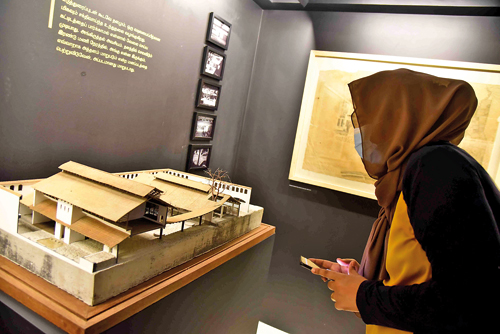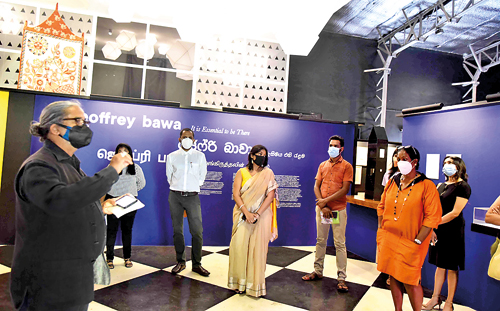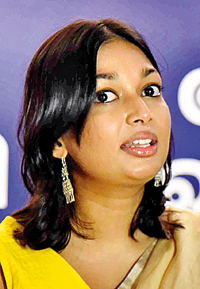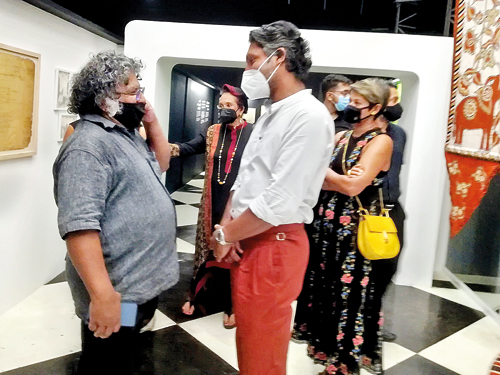If you really want to get to know Bawa, ‘It is Essential to be There’
 The Stables at the Park Street Mews will from February till April have a timeless, serenity – graced with the intimate personal touch of Geoffrey Bawa – the soul of the man and the architect.
The Stables at the Park Street Mews will from February till April have a timeless, serenity – graced with the intimate personal touch of Geoffrey Bawa – the soul of the man and the architect.
Yellowed plans, old letters, photos snatched while on his journeys (or rather pilgrimages) to Europe where he imbibed much from traditional architecture, from grand English country houses, Italian gardens and even just the flag-hung public spaces of old France or Spain. Also some unique items that defined the classic Bawa ethos from a giant Ena de Silva banner to artifacts from the Ceylon Pavilion at Expo 70 at Osaka.
Organized by the Geoffrey Bawa Trust, ‘It is Essential to be There’ is the first exhibition with material from the archives of the architect to be held in Sri Lanka.
The alluring title comes from something Geoffrey Bawa once said about his practice:
“The site gives the most powerful push to a design along with the brief. Without seeing the site I cannot work. It is essential to be there. After two hours on the site, I have a mental picture of what will be there and how the site will change and the picture does not change.”

Chairperson of the Bawa Trust Channa Daswatte explaining some of the exhibits. Pix by Akila Jayawardana
The five galleries together give a complete picture map of the great architect’s art and his creative soul, showing the different ways in which images were used in Bawa’s practice.
The first gallery is hung with maps of Ceylon and Lunuganga – the old-world maps Bawa cherished and hung in the Lunuganga house giving a whiff of vintage maritime travel and adventure.
The second gallery, ‘Situating a Practice’, celebrates the importance of the site in Bawa’s oeuvre – the idea of “building for function and form across the varied terrains of the island”.
The Ena de Silva house centred round its dappled central courtyard was an answer to Colombo’s dusty, noisy density. The Jayawardene House in Mirissa had all the structure below ground so that on the ground was a simple cement floored strip with columns, looking out to the palmy breezy cliff top and beyond that the sea.
The Yahapath Endera farm school for orphaned girls interacted with a hilly landscape of Hanwella. The Polontalawa estate bungalow was built with the natural rock boulders and trees, a far cry from the colonial tradition of prim English bungalows pitted against the wilderness.

Curator Shayari de Silva
The third gallery, ‘Searching for a Way of Building’, looks at how Bawa and his associates faced with the paucity (in the ’60s and ’70s) of reinforced steel and glass were trying to “find alternative means to express the forms and spaces they were conceiving of, using the materials at hand.”
Early on, the building with the fantastic jungle mural with hornbills at the Kollupitiya S. Thomas’ Prep school, proved that reinforced steel was no good given our climate (too near the sea, it corroded) and Bawa was put on the path to such buildings as the delightful St. Bridget’s Montessori with its monitor roof showing how the design of a building could better serve the Sri Lankan climate.
At Ladies’ College the overhanging balconies at the Simon Block offer shade to the floors below and ventilation through the classrooms. Later, there was the remarkable roof-hung floor plate at the Bentota Beach Hotel and the twelve-storey State Mortgage Bank Building (later known as the Mahaweli Building).
The latter is still celebrated as an “extraordinary effort to construct an office building which can be naturally ventilated”. Although it has been much altered today, it remains an important model for bioclimatically-responsive tall buildings.
The gallery titled ‘Defining New Directions’ looks at the path breaking and the iconic.
We linger at that classic Ceylon pavilion at the 70 Osaka Expo, still remembered as the best small pavilion there. Here with a giant stylized Bo leaf and our classic archaeological heritage, was modern batik.
Sprawling by the sea in the south is the Ruhuna University, like one convoluted marine creature joined by long corridors and ample public spaces. These encourage communal encounters in keeping with a new approach to education.

At the opening: Chandragupta Thenuwara, Nela De Zoysa, Kumar Sangakkara and wife Yeheli. Pic by Nilan Maligaspe
The exhibition also glances back at the controversy that shrouded the Kandalama Hotel, built in an environmentally and culturally sensitive location. Ironically the hotel galvanized the environmental movement in Sri Lanka, and Bawa was to remark that in his view the project would be complete when it had turned to ruin, with leopards roaming its corridors once more.
The final gallery is on ‘Places Unbuilt’, those projects that were never realized and tantalize with their sketches like the Sand Dune House Yala and the Panama Hotel.
This exhibition curated by Shayari de Silva, Curator of the Geoffrey Bawa Trust gives rare insight into as well as coherence to Bawa’s career scattered across six long decades. A short walk through will enrich and entertain.
It is Essential to be There, presented in all three languages, is open to the public free of charge. The exhibition is on until April 3 at The Stables, Park Street Mews from 11 a.m. to 7 p.m. every day.
Searching for an ideal partner? Find your soul mate on Hitad.lk, Sri Lanka's favourite marriage proposals page. With Hitad.lk matrimonial advertisements you have access to thousands of ads from potential suitors who are looking for someone just like you.


